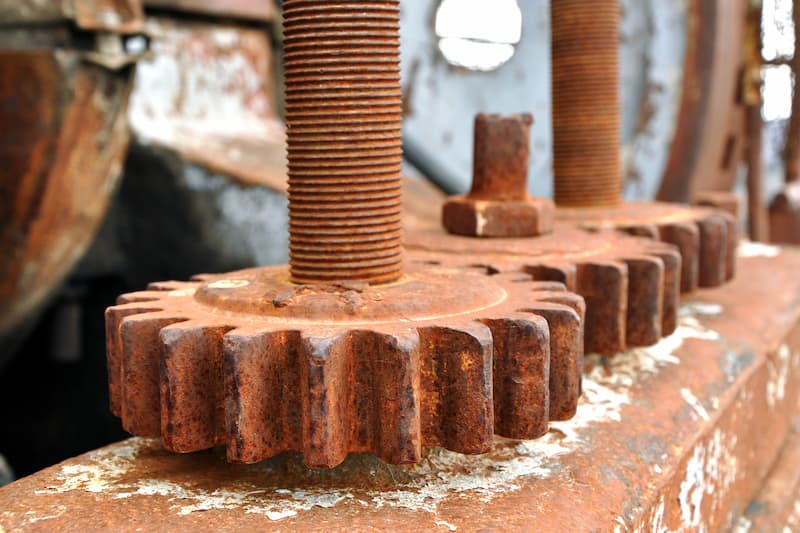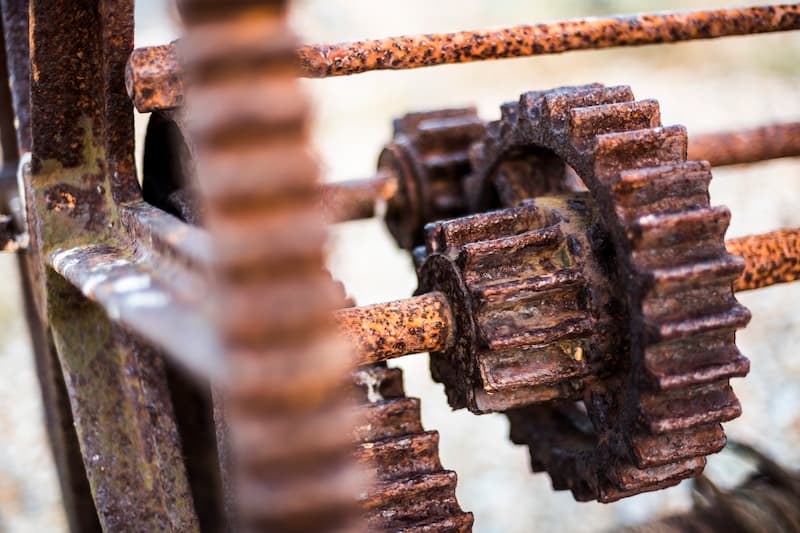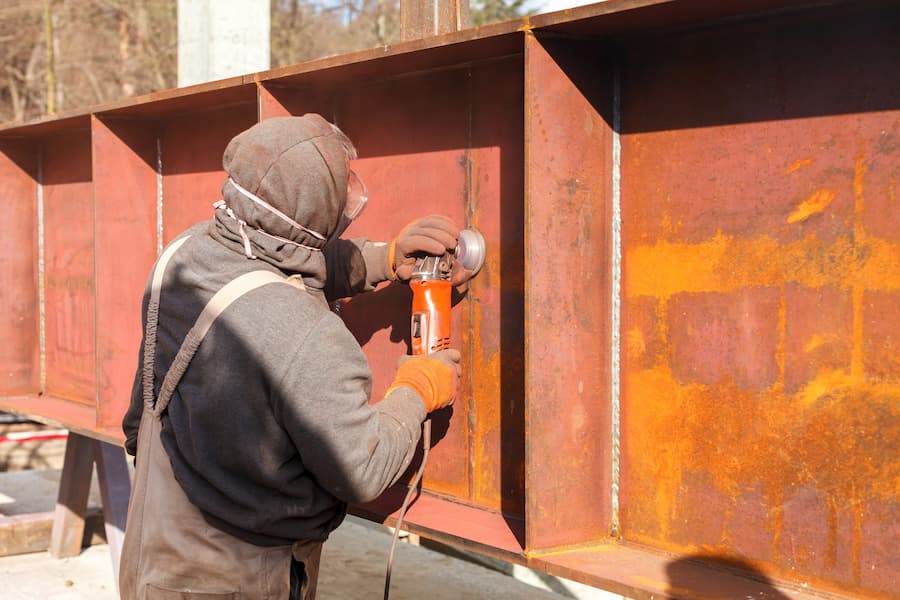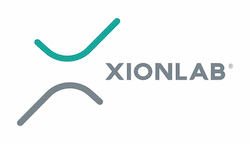Rust converters are specialized chemical products designed to convert existing rust on metal surfaces into a more stable, inert substance. Rust, which is a form of iron oxide, develops on metal surfaces due to exposure to moisture and oxygen. Over time, rust can compromise the structural integrity of metals, especially in industrial environments where large machinery, steel structures, and vehicles are constantly exposed to the elements.

Understanding Industrial Rust Converter Products
Unlike rust removers, which strip away rust entirely, a rust converter chemically transforms rust into a protective layer. This process helps neutralize corrosion, converting rust into a black primer coat that can be painted over. By using a rust converter, you eliminate the need to sandblast or manually remove rust from surfaces, making it a time-efficient and cost-effective solution for rust and corrosion management.
How Does a Rust Converter Liquid Surface Conditioner Aid in Rust Prevention?
A rust converter liquid surface conditioner works by chemically transforming rust, offering an effective solution for rust prevention. When applied, the rust converter converts rust into a more stable substance, effectively acting as a rust killer. The rust converter converts rust to an inert state, halting further corrosion. Specifically, the converter converts rust to black, creating a rust to black primer coat that seals and protects the surface. This black primer not only enhances the surface but also acts as a strong base for additional coatings.
The process converts existing rust into a dark, stable compound, preventing the spread of rust. In addition to this, many converters include a rust inhibitor, which provides long-term protection by forming a barrier that helps stop rust from reforming. The use of a rust inhibitor is essential in maintaining the integrity of metal surfaces, as it works alongside the converter to ensure rust prevention over time.
Key Components of Rust Converters
How Tannic Acid Converts Rust to Black Primer
Tannic acid is one of the key ingredients in rust converters. It reacts with the iron oxide in rust, converting it into a stable iron tannate compound. This chemical transformation converts rust to black primer, giving the surface a protective layer that not only neutralizes rust but also prepares it for further treatments like painting or sealing. The rust primer created by tannic acid provides a solid foundation for subsequent coatings, ensuring that the rusted surface is properly treated.
Phosphoric Acid’s Role in Inhibiting Future Rust
Phosphoric acid plays a vital role in rust converters by transforming rust into iron phosphate, a compound that further protects the surface. This reaction provides an excellent primer coating by inhibiting future rust formation and creating a barrier against moisture and oxygen. This excellent primer coating on rusty surfaces ensures that rust doesn’t return and maintains the integrity of the metal.
Water-Based vs. Oil-Based Rust Converters
Rust converters come in both water-based and oil-based formulations. While water-based converters are eco-friendly and biodegradable, oil-based paint versions offer a thicker, more durable coating. An oil-based paint converter also provides an excellent primer for long-term protection, especially in industrial applications where durability is key.
Primer Coating on Rusty Steel Surfaces
For surfaces like rusty steel, a rust converter provides an excellent primer coating, especially after thorough surface preparation using sand or wire brushes to remove loose rust. A primer coating on rusty steel ensures that the steel remains rust-free and well-protected, extending its lifespan.
Liquid Surface Conditioner and Primer for Enhanced Adhesion
Some rust converters contain a liquid surface conditioner and primer, which aids in providing a uniform finish. This formula not only treats the rust but also provides an excellent primer coating, improving adhesion for additional layers such as paint or sealants. It works particularly well on surfaces that need a smooth, even coating to ensure long-term rust prevention.
When to Use a Rust Converter
Rust converters are most effective on surfaces where rust converter is a liquid application is needed for early-stage rust formation. The converter is a liquid surface treatment that chemically reacts with rust to neutralize it and stop further corrosion. This type of primer converts existing rust into an inert material, halting its progress and providing long-term rust protection.

In industrial settings, rust converters are ideal for metal surfaces like steel structures, automotive parts, railings, and machinery that are exposed to moisture, salt, and corrosive environments. When existing rust begins to appear but hasn’t yet severely weakened the metal, applying a converter is the best course of action. The rust converter halts existing rust and turns it into a stable form, ensuring the treated surface remains structurally sound.
For areas with need rust treatment, a rust converter turns existing rust into an inert compound, preventing further degradation. This process also helps create a rust-proof surface, which is resistant to future corrosion and provides enhanced durability. Rust converters are especially useful in environments where preventing further rust damage is critical to the longevity of the equipment or structure.
Rust Converter vs. Rust Remover
Rust converters and rust removers serve different purposes. While rust removers chemically strip away rust from metal surfaces, rust converters work by chemically neutralizing the rust and converting it into a stable layer. Rust removers are ideal for situations where you need to restore bare metal, while rust converters are perfect for cases where rust has already developed, and you want to stabilize it without removing it entirely.

Choosing between a rust converter and a rust remover depends on the condition of the surface and the intended use. If the rust is light and you want to stop it from spreading, a rust converter is the best choice. However, if you need to bring a heavily rusted surface back to bare metal, a rust remover might be more effective.
Benefits of Using Rust Converters
Using a rust converter offers several benefits, particularly in industrial applications. First, it halts the progression of rust and corrosion, turning rust into a durable, black coating that seals out moisture and prevents future rust. This coating can then be painted over with a primer or topcoat, providing additional protection and extending the lifespan of the treated surface.
Additionally, rust converters are easy to apply and do not require extensive surface preparation. Instead of sandblasting or using harsh chemicals, you can simply apply the rust converter directly to the rusted surface. Many rust converters are also non-toxic, biodegradable, and environmentally friendly, making them a safe choice for industrial use.
Choosing the Right Industrial Rust Converter
Types of Rust Converters
Industrial rust converters come in various forms, each tailored for specific applications. Heavy-duty rust converters are ideal for larger industrial surfaces, such as truck frames, structural steel, and heavy machinery. These converters are available in both liquid and foam forms, allowing for easy application across large areas. Some converters come in water-based formulations, which are eco-friendly and non-flammable compared to other products. This makes them safer to use in enclosed environments or areas where flammable chemicals are a concern.
Foam-based rust converters are particularly useful for hard-to-reach areas like inside pipes or intricate metal parts. These converters can penetrate narrow spaces, making them effective in places where traditional liquid converters might not reach. Users who have used this product often highlight its effectiveness in complex applications, especially for treating hidden rust.
For smooth surfaces, liquid surface conditioner converters are ideal as they provide a high level of adhesion for subsequent coatings, such as primers and paints. With most rust converters, coverage is estimated at per gallon, typically treating around 200-300 sq feet of surface area. These converters also often double as a sealer, providing an additional protective layer that prevents future rust from forming, further enhancing their versatility unlike other products on the market.
Top Features to Look for in Rust Converters
When selecting a rust converter for industrial use, it’s important to consider several features:
VOC Content: Lower VOC (Volatile Organic Compounds) content, especially in water-based converters, is safer for the environment and easier to work with in enclosed spaces.
Durability: The converter should provide long-lasting protection, particularly in harsh environments. Many users report stuff works great on tough surfaces like iron and steel.
Coverage: Rust converters vary in their coverage, with most providing around 1 quart per 200 square feet. Look for converters with a non-flammable formula for added safety.
Curing Time: Depending on the type of converter, curing time may vary from a few hours to 24 hours, delivering professional results when applied correctly.
Best Industrial Rust Converter Products on the Market: Quart Options
There are several high-quality rust converters available for industrial use. Here are two popular choices:
- X Brand Rust Converter: This water-based rust converter provides a matte black finish and is eco-friendly, making it ideal for industries focused on sustainability. It offers long-lasting results with a protective coating and covers a large surface area with just 1 quart.
- Y Brand Rust Converter: Known for its oil-based formula, Y Brand offers a thicker coating and superior rust protection. It’s perfect for heavy-duty applications and provides professional-grade results.
How to Maintain and Protect Treated Surfaces with Rust Inhibitor and Customer Reviews
Even after applying a rust converter, regular maintenance is essential to ensure long-lasting protection. Inspect treated surfaces periodically to check for signs of new rust or damage. If rust begins to form again, reapply the rust converter to the affected areas and add a fresh coat of paint or sealant to maintain protection.
By following these steps, you can ensure that your industrial equipment and surfaces remain rust-free and durable, even in harsh environments.
Common Mistakes to Avoid When Using Rust Converters, Foam, and Inhibitors
- Inadequate Surface Preparation: Failing to remove loose rust before applying the converter can result in an uneven coating and poor adhesion.
- Skipping the Top Coat: Always apply a protective top coat after the rust converter has cured. This will add an extra layer of protection and prevent future rust.
- Using the Wrong Product: Be sure to select the right rust converter for your specific needs. Heavy-duty converters are better for industrial applications, while lighter versions may be more suitable for small projects.
FAQs About Rust Converters, Rust Inhibitors, and VOC
What Does a Rust Converter Do?
A rust converter chemically transforms rust into a stable, inert substance, forming a protective black coating that can be painted over.
Can a Rust Converter Stop Future Rust?
Yes, once the rust is converted into an inert material and sealed with a top coat, the surface becomes resistant to future rust formation.
What Surfaces Can Rust Converters Be Used On?
Rust converters can be used on metal surfaces such as steel, iron, automotive parts, and railings.
How Long Does a Rust Converter Last?
With proper application and a top coat, a rust converter can provide long-lasting protection, often lasting several years.
Can You Paint Over a Rust Converter?
Yes, after the rust converter has cured, you can apply a primer or top coat to improve durability and aesthetics.
Do Rust Converters Work on Automotive Parts?
Yes, rust converters are commonly used on automotive parts, such as truck frames and undercarriages, to prevent rust from spreading and causing damage.
Industrial rust converters provide an efficient and long-lasting solution to rust and corrosion problems. By converting rust into a stable, inert substance, these products help protect metal surfaces from future rust, ensuring durability in harsh environments. Whether you’re dealing with rust on a truck frame, railing, or industrial equipment, choosing the right rust converter can make all the difference in maintaining the longevity and performance of your metal surfaces.



